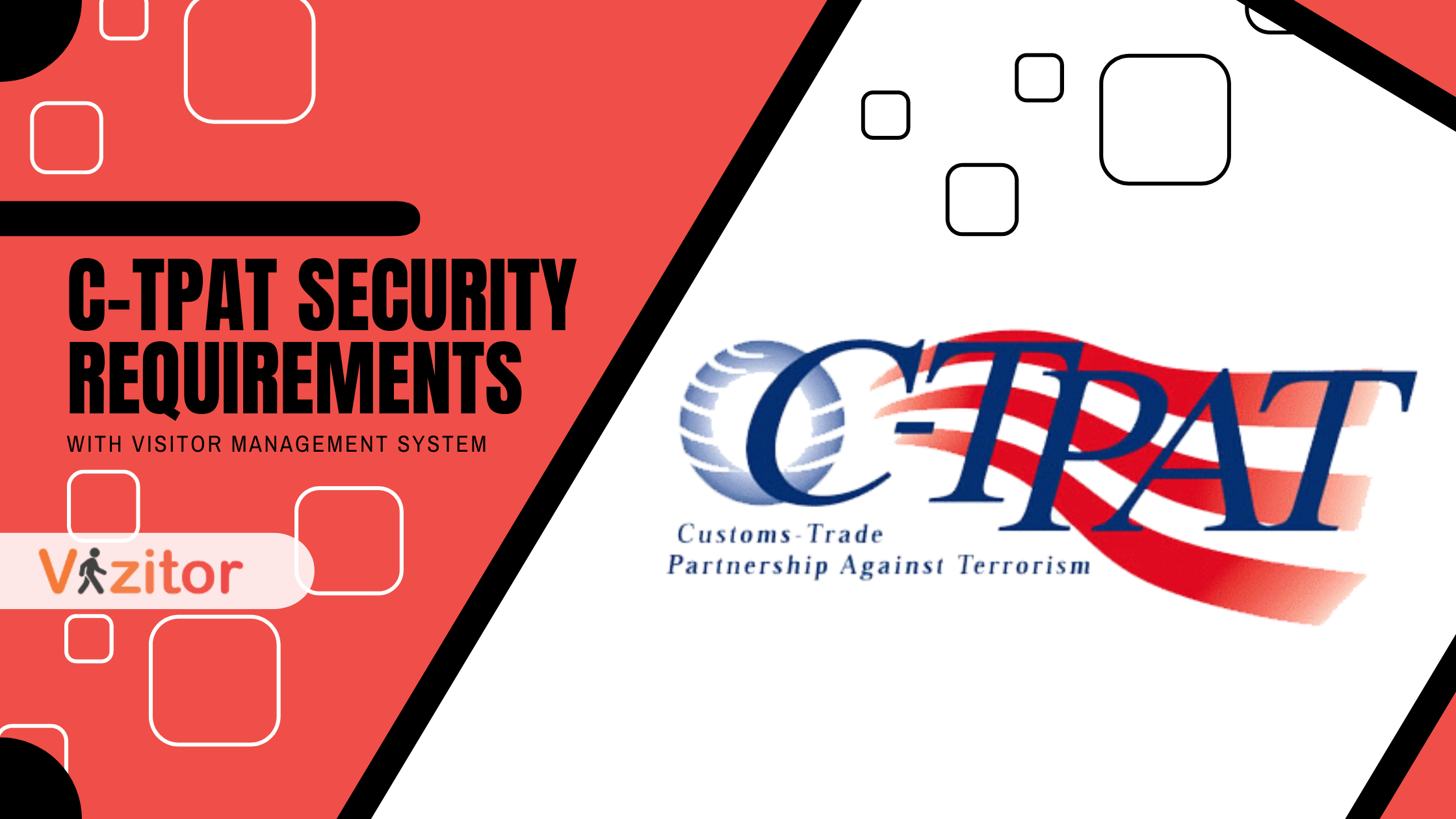Table of Content
Try Vizitor for Free!

Thu, Jun 20, 2024
Read in 11 minutes
Are you thinking about becoming C-TPAT certified?
Did you know? Companies that are C-TPAT certified can experience up to a 50% reduction in border wait times, leading to significant cost savings and improved supply chain efficiency. In today’s interconnected global economy, ensuring the security of your supply chain is more important than ever.
C-TPAT (Customs-Trade Partnership Against Terrorism) certification not only enhances your company’s security measures but also provides numerous benefits, including faster customs processing and a trusted reputation among partners and customers. By becoming C-TPAT certified, your business can demonstrate a commitment to safeguarding its operations, reducing risks, and staying ahead in a competitive market.
You can enhance the security level of your enterprise by doing a C-TPAT certification. As we all know different industries are subjected to an array of safety, security and compliance standards each with different purposes. Companies that achieve C-TPAT requirements, certification must have a documented process for determining and alleviating the risk throughout their international supply chain.
Dive into the process of C-TPAT certification with Vizitor and discover how it can transform your enterprise’s security and efficiency.
What is C-TPAT Certification?

C-TPAT (Customs-Trade Partnership Against Terrorism) certification is a voluntary, collaborative program led by U.S. Customs and Border Protection (CBP). It aims to strengthen international supply chains and improve U.S. border security by enhancing the security practices of private businesses. Companies that achieve C-TPAT certification must implement stringent security measures and processes throughout their supply chain operations, from manufacturing and logistics to shipping and receiving.
By becoming C-TPAT certified, businesses benefit from reduced customs inspections, expedited processing times, and a trusted status among global trade partners. This certification demonstrates a company’s commitment to maintaining high-security standards, reducing risks, and contributing to the protection of international trade and national security.
Core Principles Of C-TPAT Requirements
C-TPAT (Customs-Trade Partnership Against Terrorism) is a voluntary initiative by U.S. Customs and Border Protection (CBP) that aims to strengthen and improve the visitor security of international supply chains.
The core principles of C-TPAT requirements are designed to help businesses enhance their security measures and ensure compliance with global trade security standards.
Here are the key principles:
1. Business Partner Requirements
Screening and Selection: Ensure that business partners (manufacturers, vendors, suppliers, etc.) adhere to C-TPAT security guidelines.
Verification: Conduct due diligence and periodic reviews to verify compliance with security measures.
2. Container Security
Inspection: Inspect all containers and trailers for tampering and unauthorized access before loading.
Seals: Use high-security seals on containers and maintain a record of seal numbers.
3. Physical Access Controls
Employee Identification: Implement identification procedures for employees, visitors, and vendors.
Access Control: Restrict access to sensitive areas and facilities to authorized personnel only.
4. Personnel Security
Background Checks: Perform background checks on prospective employees and periodically review current employees.
Training: Provide security training to employees on recognizing threats and reporting suspicious activities.
5. Physical Security
Fencing: Secure the facility perimeter with appropriate fencing.
Lighting: Ensure adequate lighting inside and outside the facility.
Surveillance: Use security cameras to monitor key areas and deter unauthorized access.
6. Procedural Security
Documentation: Establish procedures for the handling, storage, and transportation of goods.
Shipping and Receiving: Implement procedures for verifying incoming and outgoing shipments.
7. Information Technology Security
Network Security: Protect IT systems from unauthorized access with firewalls, passwords, and other security measures.
Data Protection: Ensure the confidentiality and integrity of data by using encryption and secure data storage practices.
8. Security Training and Threat Awareness
Training Programs: Develop and maintain a comprehensive security training program for employees.
Awareness: Foster a culture of security awareness and encourage employees to report suspicious activities.
9. Crisis Management and Incident Recovery
Preparedness: Develop a crisis management plan to respond to security incidents and disruptions.
Recovery: Establish procedures for quickly resuming normal operations after an incident.
10. Conveyance Security
Vehicle Inspection: Regularly inspect vehicles for tampering and ensure they meet security standards.
Driver Security: Train drivers on security protocols and ensure they are aware of the importance of secure transportation.
Benefits Offered to C-TPAT-Certified Company
C-TPAT certification offers several benefits to companies committed to securing their supply chains and complying with international trade security standards. Here are some of the key benefits:
- Expedited Processing: C-TPAT-certified companies often experience faster customs processing and reduced inspection times at borders. This can lead to smoother and more efficient trade operations, minimizing delays in shipments.
- Priority Treatment: CBP gives priority treatment to C-TPAT-certified shipments, which may result in fewer physical inspections and expedited clearance through customs checkpoints.
- Improved Security: By implementing C-TPAT security measures, companies enhance their overall security posture, reducing the risk of cargo theft, tampering, and unauthorized access during transit.
- Global Recognition: C-TPAT certification is recognized globally as a mark of excellence in supply chain security. It can enhance a company’s reputation and credibility among international partners, customers, and stakeholders.
- Cost Savings: Reduced inspection times and improved security measures can lead to cost savings for C-TPAT-certified companies. This includes savings on labour costs, storage fees, and potential penalties for non-compliance.
- Supply Chain Resilience: C-TPAT certification helps companies build a more resilient supply chain by mitigating risks and vulnerabilities. This resilience can protect against disruptions and ensure continuity of operations during emergencies or crises.
- Customized Security Plans: C-TPAT-certified companies develop customized security plans tailored to their specific operations and supply chain requirements. These plans focus on risk assessment, prevention, and response strategies.
- Access to Best Practices: C-TPAT certification provides access to best practices in supply chain security, including guidance on physical security, personnel training, IT security, and crisis management. This knowledge helps companies strengthen their security programs.
- Collaboration Opportunities: C-TPAT certification encourages collaboration and information sharing among supply chain partners, government agencies, and law enforcement. This collaborative approach fosters a stronger security culture and promotes industry-wide security standards.
- Competitive Advantage: Being C-TPAT-certified can give companies a competitive advantage in the marketplace. It demonstrates a commitment to security, compliance, and responsible business practices, which can attract customers and business opportunities.
Basic Requirements for C-TPAT Security
The basic requirements for C-TPAT (Customs-Trade Partnership Against Terrorism) security encompass several key areas that companies must address to enhance the security of their supply chains. Here are the fundamental requirements:
- Risk Assessment: Conduct a comprehensive risk assessment of your supply chain to identify vulnerabilities, threats, and potential security risks. This assessment should cover all aspects of your operations, including suppliers, transportation, storage, and handling of goods.
- Physical Security: Implement physical security measures to protect facilities, warehouses, and storage areas. This includes access control systems, security fencing, surveillance cameras, lighting, and alarm systems.
- Personnel Security: Screen and train personnel involved in supply chain operations to ensure they understand security protocols, recognize suspicious activities, and respond appropriately to security incidents. Conduct background checks on employees and contractors as part of personnel security measures.
- Access Controls: Establish strict access controls to restrict entry to authorized personnel only. Use identification badges, biometric systems, visitor logs, and visitor management procedures to monitor and control access to facilities and sensitive areas.
- Container Security: Secure shipping containers and cargo to prevent tampering, theft, or unauthorized access during transit. Use high-security seals, inspect containers before loading, and implement procedures for verifying container integrity.
- IT Security: Protect IT systems and data related to supply chain operations from cyber threats, unauthorized access, and data breaches. Implement cybersecurity measures such as firewalls, encryption, access controls, and regular security audits.
- Documentation and Record-Keeping: Maintain accurate and up-to-date documentation of supply chain activities, transactions, and security measures. Keep records of security audits, inspections, training sessions, and incident reports as part of compliance requirements.
- Training and Awareness: Provide regular training and awareness programs for employees, suppliers, and partners on supply chain security practices, procedures, and protocols. Foster a culture of security awareness and encourage reporting of suspicious activities.
- Incident Response: Develop and implement procedures for responding to security incidents, breaches, or emergencies within the supply chain. Establish communication protocols, contingency plans, and crisis management strategies to mitigate risks and minimize disruptions.
- Compliance and Audits: Ensure ongoing compliance with C-TPAT security requirements through regular audits, self-assessments, and validations. Cooperate with CBP (Customs and Border Protection) and other authorities during security reviews, inspections, and certifications.
CTPAT Visitor Management Process Framework
Having a good visitor management process is important for meeting CTPAT (Customs-Trade Partnership Against Terrorism) certification standards. This framework explains the key steps and components needed to ensure security and compliance in an organization.
1. Pre-Visit Procedures
Visitor Pre-Registration: Use an online system for visitors to register before their visit.
Collect personal details, the reason for the visit, and the expected duration.
Background Checks: Perform background checks, especially for those entering sensitive areas. Verify identities against security databases.
Appointment Confirmation: Send emails with visit details, entry procedures, and security guidelines.
2. Arrival and Check-In
Identification Verification: Require valid photo ID (e.g., passport, driver’s license) upon arrival.
Match ID information with pre-registration data.
Badge Issuance: Give temporary badges with photos, names, dates, and access levels.
Use color-coded badges for different access levels.
Security Briefing: Provide a brief orientation on security, emergency procedures, and restricted areas.
Ensure visitors understand and acknowledge the security protocols.
3. Access Control
Escort Policies: Assign escorts for visitors entering high-security areas.
Ensure visitors are always accompanied by authorized personnel.
Electronic Access Systems: Use electronic systems to monitor and control visitor movements.
Link visitor badges to access control systems for real-time monitoring.
Surveillance: Install CCTV cameras in key areas to monitor activities. Regularly review footage for any suspicious behavior.
4. During the Visit
Monitoring and Logging: Keep a real-time log of visitor locations and movements. Use management software to track and document interactions.
Limited Access: Restrict visitor access to only the necessary areas. Use physical barriers and electronic locks to prevent unauthorized access.
Communication Protocols: Make sure visitors know how to communicate in emergencies.
- Provide contact information for escorts and security personnel.
5. Departure and Check-Out
Badge Return: Collect visitor badges when they leave.
Ensure all badges are returned and deactivate electronic access.
Exit Interview: Conduct a brief exit interview for feedback and to check for security breaches. Document any incidents or concerns from visitors.
Record Keeping: Keep detailed records of visitor information, visit duration, and areas accessed. Store records securely and make them accessible for audits and reviews.
6. Post-Visit Procedures
Review and Audit: Regularly review visitor logs and access records for any issues.
Conduct periodic audits to ensure compliance with CTPAT requirements.
Incident Management: Implement a process for investigating and addressing security incidents involving visitors.
Document findings and take necessary corrective actions.
Continuous Improvement: Get feedback from visitors and employees to identify improvement areas. Update visitor management CTPAT policies and procedures based on audit findings and feedback.
Wrapping It Up

Using a strong Visitor Management System (VMS) like Vizitor makes it much easier to meet the complex rules of C-TPAT. With Vizitor, companies can manage who comes in, check their identity, and control where they can go. This lets them focus on working with partners around the world confidently and efficiently.
Investing in a good and quick VMS like Vizitor not only makes sure a company follows C-TPAT rules but also makes work smoother and improves how people see the company. Vizitor has smart features like checking visitors in real time, confirming their identity, and keeping records. This helps reduce the company’s risks and makes the workplace safer.
By using Vizitor, companies show they care about security and stay ahead in protecting their work. This shows they are smart and ready to compete well globally. Choosing modern solutions like Vizitor isn’t just about safety; it’s about being efficient, trustworthy, and top-notch, which is key for long-term success.
Frequently Asked Questions
1. What are C-TPAT security criteria?
C-TPAT security criteria include risk assessment, physical security, personnel security, access controls, IT security, and procedural security. These criteria help companies protect their supply chains from security threats.
2. What are the three focus areas of C-TPAT minimum security criteria?
The three main focus areas are:
- Physical security – Secure facilities, containers, and cargo.
- Personnel security – Conduct background checks and training.
- Procedural security – Ensure compliance in shipping and receiving processes.
3. What is C-TPAT global security verification?
C-TPAT global security verification is a process used to validate whether a company meets international security standards. CBP reviews security measures and performs audits to ensure compliance.
4. What is C-TPAT compliance?
C-TPAT compliance means a company meets the security requirements established by U.S. Customs and Border Protection (CBP) to secure its supply chain, prevent tampering, and reduce customs risks.
5. What are the password requirements for C-TPAT?
Companies must implement strong password policies, including:
- A minimum of 12 characters
- A mix of letters, numbers, and special characters
- Regular password changes every 90 days
- Multi-factor authentication (MFA) for sensitive data access
6. What do visitors need for C-TPAT compliance?
Visitors may need to:
- Provide valid identification before entering the facility
- Undergo security screenings based on C-TPAT protocols
- Wear visitor badges with limited access credentials
- Sign NDAs to prevent unauthorized data exposure
7. What is a C-TPAT Compliant Visitor Log System?
A C-TPAT-compliant Visitor Log System digitally records visitor entries, manages access levels, and provides audit-ready logs for CBP inspections.
8. What are the C-TPAT requirements for manufacturers?
Manufacturers must:
- Conduct risk assessments
- Implement cargo security measures
- Train employees on C-TPAT procedures
- Maintain documentation for compliance audits









